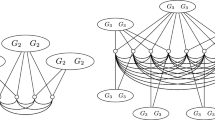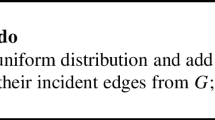Abstract
Given an undirected graph and \({0\le\epsilon\le1}\), a set of nodes is called an \({\epsilon}\)-near clique if all but an \({\epsilon}\) fraction of the pairs of nodes in the set have a link between them. In this paper we present a fast synchronous network algorithm that uses small messages and finds a near-clique. Specifically, we present a constant-time algorithm that finds, with constant probability of success, a linear size \({\epsilon}\)-near clique if there exists an \({\epsilon^3}\)-near clique of linear size in the graph. The algorithm uses messages of O(log n) bits. The failure probability can be reduced to n −Ω(1) by increasing the time complexity by a logarithmic factor, and the algorithm also works if the graph contains a clique of size Ω(n/(log log n)α) for some \({\alpha \in (0,1)}\). Our approach is based on a new idea of adapting property testing algorithms to the distributed setting.
Similar content being viewed by others
References
Abello, J., Resende, M.G.C., Sudarsky, S.: Massive quasi-clique detection. In: LATIN ’02: Proceedings of the 5th Latin American Symposium on Theoretical Informatics, pp. 598–612. Springer, London, UK (2002)
Alon N., Babai L., Itai A.: A fast and simple randomized parallel algorithm for the maximal independent set problem. J. Algorithms 7, 567–583 (1986)
Awerbuch B.: Complexity of network synchronization. J. ACM. 32(4), 804–823 (1985)
Basagni S., Mastrogiovanni M., Panconesi A., Petrioli C.: Localized protocols for ad hoc clustering and backbone formation: a performance comparison. IEEE. Trans. Parallel. Dist. Syst. 17(4), 292–306 (2006)
Brin S., Page L.: The anatomy of a large-scale hypertextual web search engine. Comput. Netw. ISDN. Syst. 30(1–7), 107–117 (1998)
Broder, A.Z., Glassman, S.C., Manasse M.S., Zweig, G.: Syntactic clustering of the web. In: Selected papers from the 6th International Conference on World Wide Web, pp. 1157–1166, Elsevier, Essex, UK (1997)
Feige U., Langberg M.: Approximation algorithms for maximization problems arising in graph partitioning. J. Algorithms 41(2), 174–211 (2001)
Feige U., Peleg D., Kortsarz G.: The dense k-subgraph problem. Algorithmica 29(3), 410–421 (2001)
Fischer, E., Newman, I.: Testing versus estimation of graph properties. In: Proceedings of 37th Annual ACM Symposium on Theory of Computing, pp. 138–146. ACM, New York (2005)
Goldreich O., Goldwasser S., Ron D.: Property testing and its connection to learning and approximation. J. ACM 45(4), 653–750 (1998)
Goldreich, O., Trevisan, L.: Three theorems regarding testing graph properties. Random Struct. Algorithms 23(1), 23–57 (2003) (Preliminary version in FOCS ’01)
Gupta, R., Walrand, J.: Approximating maximal cliques in ad-hoc networks. In: Proceedings of IEEE International Symposium on Personal, Indoor and Mobile Radio Communications, pp. 365–369, Barcelona (2004)
Håstad J.: Clique is hard to approximate within \({n^{1-\epsilon}}\). Acta Mathematica 182(1), 105–142 (1999)
Kumar R., Novak J., Raghavan P., Tomkins A.: On the bursty evolution of blogspace. World Wide Web 8(2), 159–178 (2005)
Lempel R., Moran S.: SALSA: the stochastic approach for link-structure analysis. ACM. Trans. Inf. Syst. 19(2), 131–160 (2001)
Luby M.: A simple parallel algorithm for the maximal independent set problem. SIAM. J. Comput. 15(4), 1036–1053 (1986)
Nguyen, H.N., Onak, K.: Constant-time approximation algorithms via local improvements. In: FOCS, pp. 327–336. IEEE Computer Society (2008)
Parnas M., Ron D.: Approximating the minimum vertex cover in sublinear time and a connection to distributed algorithms. Theor. Comput. Sci. 381(1–3), 183–196 (2007)
Parnas, M., Ron, D., Rubinfeld, R.: Tolerant property testing and distance approximation. J. Comput. Syst. Sci. 72(6):1012–1042 (2006) (Preliminary version in STOC ’05)
Peleg D.: Distributed Computing: A Locality-sensitive Approach. SIAM, Philadelphia, PA (2000)
Rubinfeld R., Sudan M.: Robust characterizations of polynomials with applications to program testing. SIAM. J. Comput. 25(2), 252–271 (1996)
Saks M.E., Seshadhri C.: Parallel monotonicity reconstruction. In: Teng, S.-H (ed.) SODA, pp. 962–971. SIAM, Philadelphia, PA (2008)
Author information
Authors and Affiliations
Corresponding author
Additional information
B. Patt-Shamir was supported in part by the Israel Science Foundation grant 1372/09, and by Israel Ministry of Science and Technology.
Rights and permissions
About this article
Cite this article
Brakerski, Z., Patt-Shamir, B. Distributed discovery of large near-cliques. Distrib. Comput. 24, 79–89 (2011). https://doi.org/10.1007/s00446-011-0132-x
Received:
Accepted:
Published:
Issue Date:
DOI: https://doi.org/10.1007/s00446-011-0132-x




